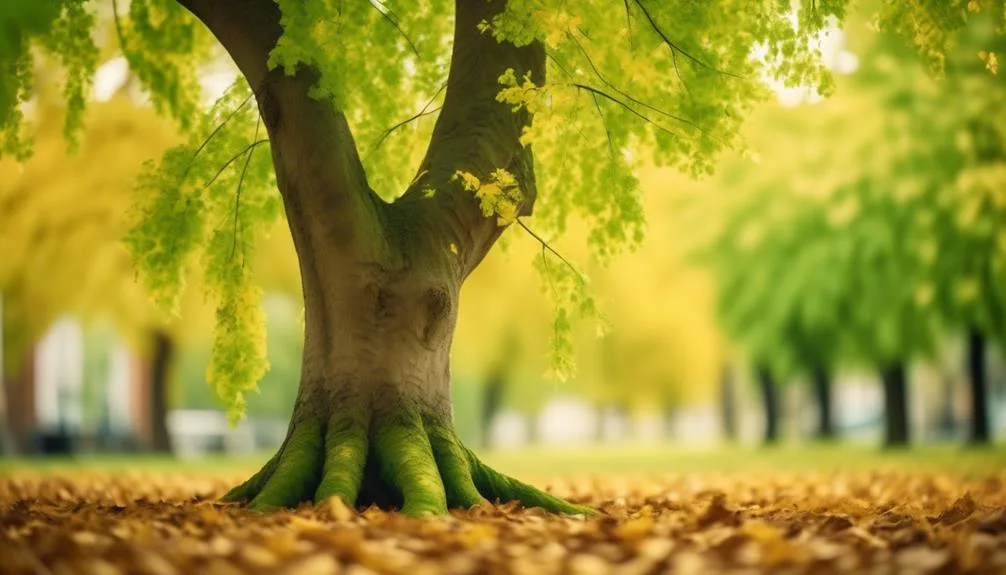Ever seen an elm tree lose its leaves in the middle of summer? It's not a usual sight.
Understanding why this happens can give us a peek into the world of tree biology. Several factors, like the environment, diseases, and pests, play a role in this early leaf drop.
It's a fascinating topic that sheds light on the complex lives of trees.
Elm Tree Characteristics
Elm trees, known for their graceful, arching branches and serrated leaves, are a common sight in many landscapes. Their growth is relatively fast, and with proper care, they can reach impressive heights. Elm tree growth is characterized by a strong central leader and lateral branches that form a broad, rounded crown.
To maintain their health and appearance, pruning techniques are essential. Proper pruning can help remove dead or diseased branches, improve tree structure, and promote overall tree health. It's important to prune elms during their dormant season to minimize stress and avoid the spread of diseases.
When pruning, be sure to make clean cuts and avoid damaging the branch collar. By following these pruning techniques, you can help ensure the longevity and beauty of your elm trees.
Environmental Factors
Losing their leaves early can be a sign that elm trees are experiencing stress from various environmental factors. Climate change plays a significant role in disrupting the natural patterns of elm tree growth and development. Seasonal variations, such as unseasonable temperature fluctuations, can also impact the health of elm trees, leading to premature leaf loss.
Environmental stressors like prolonged drought or excessive rainfall can further exacerbate the situation, causing the trees to shed their leaves prematurely. Additionally, pollution and urbanization can introduce additional stress, affecting the overall health of elm trees.
It's essential to understand and address these environmental factors to ensure the long-term survival of elm trees in the face of changing climatic conditions.
Disease and Pests
Experiencing stress from various environmental factors, such as climate change and urbanization, can make elm trees more susceptible to diseases and pests, impacting their overall health and vitality. Fungal infections and insect infestations are common issues that contribute to early leaf drop and compromise tree health. Fungal infections like Dutch elm disease and anthracnose can cause premature leaf shedding, weakening the tree's ability to photosynthesize and store energy for the winter. Insect infestations from pests like elm leaf beetles and elm bark beetles can also lead to early leaf loss and overall tree decline. These stressors not only result in the premature loss of leaves but can also lead to long-term damage if left unmanaged. Below is a table summarizing common diseases and pests affecting elm trees.
| Disease/Pest | Impact | Signs and Symptoms |
|---|---|---|
| Dutch elm disease | Causes wilting and death | Yellowing and wilting leaves, brown streaks in sapwood |
| Anthracnose | Causes defoliation | Irregular brown spots on leaves, dieback of twigs |
| Elm leaf beetles | Defoliates trees | Skeletonized leaves, early leaf drop |
| Elm bark beetles | Spread Dutch elm disease | Entrance holes in bark, sawdust-like frass |
Stress and Damage
Under the strains of environmental pressures, such as climate change and urbanization, elm trees become more vulnerable to diseases and pests, which can significantly impair their overall well-being. Stress factors, like extreme weather conditions and soil compaction, weaken the trees, making them more susceptible to damage.
As a result, the leaves may exhibit signs of distress, such as discoloration and premature shedding. The tree's ability to photosynthesize and provide essential nutrients to its leaves is compromised, leading to early leaf loss. Additionally, physical damage from construction or landscaping activities can further stress the trees, causing them to lose their leaves prematurely.
These combined stressors can significantly impact the health and longevity of elm trees, making it crucial to address and mitigate these environmental pressures to ensure their well-being.
Adaptation and Survival
Amidst the challenges posed by environmental pressures, elm trees demonstrate remarkable resilience in adapting to their changing surroundings, showcasing their capacity for survival in diverse conditions. Climate change has intensified these pressures, leading to earlier leaf loss among elm trees. However, their evolutionary advantage becomes evident in their ability to adapt. Elm trees have developed mechanisms to cope with these changes, such as adjusting their growth patterns and modifying their water usage. This resilience allows them to thrive in the face of adversity, making them a symbol of strength and adaptability in the natural world. The following table outlines the key strategies elm trees employ to survive in changing climates:
| Survival Strategy | Description |
|---|---|
| Growth pattern adjustment | Elm trees alter their growth patterns to optimize resource utilization. |
| Water usage modification | They adjust their water usage to cope with changing environmental conditions. |
Conclusion
In observing elm trees shedding their leaves early, we witness their ability to adapt and endure in the face of various challenges. This natural process serves as a reminder of their resilience and preparation for the coming winter.
Let's continue to appreciate and monitor the health of these trees in our surroundings.

My interest in trees started when I first saw the giant sequoias in Yosemite.
I was a teenager then, and I remember thinking, “I need to learn more about this.”
That moment stuck with me.
A few years later, I went on to study forestry at Michigan Tech.
Since graduating, I’ve worked in a mix of hands-on tree care and community education.
I’ve spent over ten years helping people understand how to plant, maintain, and protect the trees in their neighborhoods.
I don’t see trees as just part of the landscape.
They are living things that make a real difference in our daily lives.
